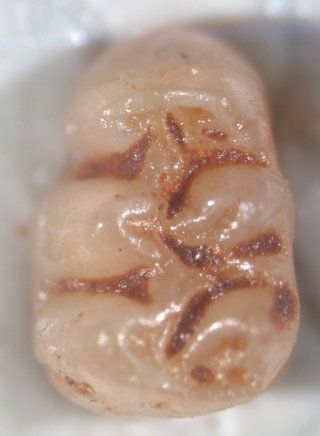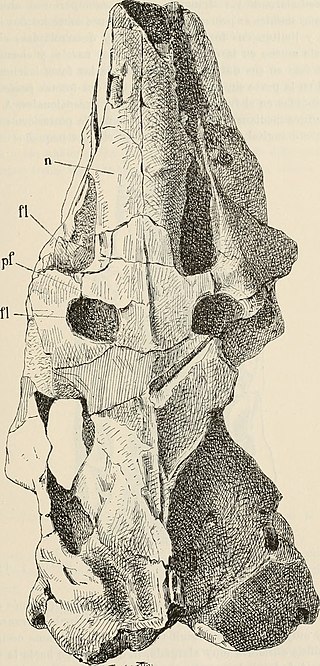
The Bovidae comprise the biological family of cloven-hoofed, ruminant mammals that includes cattle, yaks, bison, buffalo, antelopes, sheep and goats. A member of this family is called a bovid. With 143 extant species and 300 known extinct species, the family Bovidae consists of 11 major subfamilies and thirteen major tribes. The family evolved 20 million years ago, in the early Miocene.

Lundomys molitor, also known as Lund's amphibious rat or the greater marsh rat, is a semiaquatic rat species from southeastern South America.

Pseudoryzomys simplex, also known as the Brazilian false rice rat or false oryzomys, is a species of rodent in the family Cricetidae from south-central South America. It is found in lowland palm savanna and thorn scrub habitats. It is a medium-sized species, weighing about 50 grams (1.8 oz), with gray–brown fur, long and narrow hindfeet, and a tail that is about as long as the head and body. The IUCN has assessed its conservation status as being of least concern, although almost nothing is known about its diet or reproduction.

Mindomys hammondi, also known as Hammond's rice rat or Hammond's oryzomys, is an endangered species of rodent in the tribe Oryzomyini of family Cricetidae. Formerly considered to be related with Nectomys, Sigmodontomys, Megalomys, or Oryzomys, it is now placed in then genus Mindomys, but its relationships remain obscure; some evidence supports a placement near Oecomys or as a basal member of Oryzomyini.

Eremoryzomys polius, also known as the gray rice rat or the Marañon oryzomys, is a rodent species in the tribe Oryzomyini of the family Cricetidae. Discovered in 1912 and first described in 1913 by Wilfred Osgood, it was originally placed in Oryzomys and named Oryzomys polius. In 2006, a cladistic analysis found that it was not closely related to Oryzomys in the strict sense or to any other oryzomyine then known, so that it is now placed in its own genus, Eremoryzomys. The Brazilian genus Drymoreomys, named in 2011, is probably the closest relative of Eremoryzomys. Eremoryzomys has a limited distribution in the dry upper valley of the Marañón River in central Peru, but may yet contain more than one species.

Lufengpithecus is an extinct genus of ape, known from the Late Miocene of East Asia. It is known from thousands of dental remains and a few skulls and probably weighed about 50 kg (110 lb). It contains three species: L. lufengensis, L. hudienensis and L. keiyuanensis. Lufengpithecus lufengensis is from the Late Miocene found in China, named after the Lufeng site and dated around 6.2 Ma. Lufengopithecus is either thought to be the sister group to Ponginae, or the sister to the clade containing Ponginae and Homininae.

Noronhomys vespuccii, also known as Vespucci's rodent, is an extinct rat species from the islands of Fernando de Noronha off northeastern Brazil. Italian explorer Amerigo Vespucci may have seen it on a visit to Fernando de Noronha in 1503, but it subsequently became extinct, perhaps because of the exotic rats and mice introduced by the first explorers of the island. Numerous but fragmentary fossil remains of the animal, of uncertain but probably Holocene age, were discovered in 1973 and described in 1999.

Carletonomys cailoi is an extinct rodent from the Pleistocene (Ensenadan) of Buenos Aires Province, Argentina. Although known only from a single maxilla with the first molar, its features are so distinctive that it is placed in its own genus, Carletonomys. Discovered in 1998 and formally described in 2008, it is part of a well-defined group of oryzomyine rodents that also includes Holochilus, Noronhomys, Lundomys, and Pseudoryzomys. This group is characterized by progressive semiaquatic specializations and a reduction in the complexity of molar morphology.

Juliomys anoblepas is a rodent in the genus Juliomys of the subfamily Sigmodontinae known from a single broken skull. The specimen was collected by Peter Wilhelm Lund in the caves of Lagoa Santa, Minas Gerais, Brazil, in the first half of the 19th century and described by Herluf Winge in 1888 as Calomys anoblepas. The species remained unstudied and its affinities unclear until 2011, when it was recognized as a member of the genus Juliomys, which includes three other species from southern Brazil and nearby Argentina and Paraguay. J. anoblepas is probably a separate extinct species of the genus, which is no longer found at Lagoa Santa.

Transandinomys is a genus of rodents in the tribe Oryzomyini of family Cricetidae. It includes two species—T. bolivaris and T. talamancae—found in forests from Honduras in Central America south and east to southwestern Ecuador and northwestern Venezuela in northern South America. Until 2006, its members were included in the genus Oryzomys, but phylogenetic analysis showed that they are not closely related to the type species of that genus, and they have therefore been placed in a new genus. They may be most closely related to genera like Hylaeamys and Euryoryzomys, which contain very similar species. Both species of Transandinomys have had eventful taxonomic histories.

Hipposideros besaoka is an extinct bat from Madagascar in the genus Hipposideros. It is known from numerous jaws and teeth, which were collected in a cave at Anjohibe in 1996 and described as a new species in 2007. The site where H. besaoka was found is at most 10,000 years old; other parts of the cave have yielded H. commersoni, a living species of Hipposideros from Madagascar, and some material that is distinct from both species. H. besaoka was larger than H. commersoni, making it the largest insectivorous bat of Madagascar, and had broader molars and a more robust lower jaw. As usual in Hipposideros, the second upper premolar is small and displaced from the toothrow, and the second lower premolar is large.
Miniopterus tao is a fossil bat in the genus Miniopterus from the Pleistocene of Zhoukoudian in China. It is known from a number of mandibles, which were initially identified as the living species Miniopterus schreibersii in 1963 before being recognized as a separate species, M. tao, in 1986. Miniopterus tao is larger than living M. schreibersii and has more closely spaced lower premolars and more robust talonids on the lower molars. The back part of the mandible is relatively low and on it, the coronoid and condyloid processes are about equally high. The average length of the mandible is 12.0 mm.

Agathaeromys is an extinct genus of oryzomyine rodents from the Pleistocene of Bonaire, Netherlands Antilles. Two species are known, which differ in size and some details of tooth morphology. The larger A. donovani, the type species, is known from hundreds of teeth that are probably 900,000 to 540,000 years old, found in four localities. A. praeuniversitatis, the smaller species, is known from 35 teeth found in a single fossil site, which is probably 540,000 to 230,000 years old.

The Malagasy mountain mouse or Koopman's montane voalavo is a rodent within the subfamily Nesomyinae of the family Nesomyidae. It is monotypic within the genus Monticolomys, and is closely related to the big-footed mouse (Macrotarsomys). It is found in the highlands of eastern Madagascar. A small mouse-like rodent, it is dark brown on the upperparts and dark gray below. It has small, rounded, densely haired ears and broad feet with well-developed pads. The long tail lacks a tuft at the tip. The skull is delicate and lacks crests and ridges on its roof.
Dermotherium is a genus of fossil mammals closely related to the living colugos, a small group of gliding mammals from Southeast Asia. Two species are recognized: D. major from the Late Eocene of Thailand, based on a single fragment of the lower jaw, and D. chimaera from the Late Oligocene of Thailand, known from three fragments of the lower jaw and two isolated upper molars. In addition, a single isolated upper molar from the Early Oligocene of Pakistan has been tentatively assigned to D. chimaera. All sites where fossils of Dermotherium have been found were probably forested environments and the fossil species were probably forest dwellers like living colugos, but whether they had the gliding adaptations of the living species is unknown.

Hemibos is an extinct even-toed ungulate belonging to the family Bovidae. Its fossil remains were found across Asia and Europe such as from China, Italian Peninsula, Iberian Peninsula, and State of Palestine, Israel, Pakistan, India.

Hemihegetotherium is an extinct genus of hegetotheriid notoungulate that lived from the Middle to the Late Miocene of what is now Argentina.
Archaeogaia is an extinct genus of notoungulates that lived during the Early and Middle Paleocene of what is now Argentina. It is one of the oldest known unequivocal notoungulates.
Hegetotheriopsis is an extinct genus of hegetotheriid notoungulate. It lived from the Late Oligocene to the Early Miocene, and its fossilized remains are found in Argentina.

Palaeohypsodontus is an extinct genus of small size Bovidae from Oligocene with unclear systematic position. It was originally described from a jaw fragment for P. asiaticus, from Mongolia, Middle Oligocene. The second species, P. zinensis was found in the Upper Oligocene of Pakistan and China.















